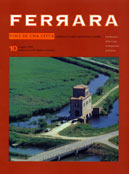But despite the magnificence of the dowry and the trousseau given her by her father the Pope, Lucrezia's marriage did not begin under the most favourable auspices. Alfonso had been against it and had bowed to paternal pressure with reluctance; duke Ercole had haggled mercilessly over the dowry; Lucrezia's future sister-in-law, Isabella, hated her even before she met her.
Yet Lucrezia managed to make herself respected and loved. The old duke liked her from the start: like a good father, he took her with him to the Barco to watch the falcons and to hunt hares and foxes. Alfonso immediately appreciated her charms, but was also touched by a disarming sweetness that aroused his protective instincts. When Lucrezia died, before her fortieth birthday, contemporaries reported that Alfonso seemed «prostrated, as if he had had the fever for some days».
At one of the first receptions held in honour of the Ferraresi who had come to Rome to escort their future duchess, Lucrezia had appeared in dazzling attire, dressed in white and gold, wearing the typical Spanish mantle - the sbarenia - lined with sable; but during the festivities that followed, until 6 January 1502, the day of her departure, she appeared in the more sombre hues of luxury, red and black, whose opulence rivalled that of gold and silver, of which she also made abundant use for many of her outfits.
At the beginning of the 17th century, red colouring was the product of rare dyestuffs used to tint the silk yarn destined for the most important textiles, like velvet or damask. The most prized hue - cremisino, or crimson -came from a substance of animal origin, imported to Europe from southern Asia.
The great value of black - whose capacity to enhance her fair good looks Lucrezia seemed to have sensed and exploited to the utmost - lay in the fact that this tint could only be obtained by employing a blend of substances rich in tannin and other ferrous ingredients that corroded the silk fibres and thus reduced their useful life span.
There is only one blue note in the inventory of the wardrobe: a baschina (a dress composed of skirt and bodice), which was later to be unmade in order to create an altar piece to be given to the nuns of the Body of Christ. Lucrezia chose black for the day of her solemn entiy into Ferrara. She rode into the city at the centre of the procession, below a canopy borne by the Doctors of the local university.
She wore black velvet with gold strips, over which fell her long blonde tresses, barely contained by a net of gold and diamonds, a gift from her father-in-law, who had also given her a superb necklace of pearls and rubies, formerly the property of the late duchess Eleanora.
Apart from the flaming intensity of cremisino, the other allies of her beauty were the full, dark colours: apart from black and morello, the inventory repeatedly mentions berrettino - a brownish grey - and pavonazzo, that is, an intense violet.
The description of her dresses, however, reveals the rigour of these shades, which were always enlivened by gold and silver: both as decorative elements applied profusely to the clothes, and as yarns.
As far as the use of textiles woven with gold or silver yarn is concerned, we have a description written in February 1502 by the marchioness of Cotrone, who talks of morello silk interwoven with gold strips two fingers wide arranged in a herringbone pattern. Another dress, worn for a ball just after the wedding, was in crimson velvet with vertical gold and silver stripes, which Lucrezia wore with diamonds at the neck and brow.
Gold was often used for the handles of Lucrezia's fans -still made of feathers because the folding variety had yet to be introduced to Europe from the Far East - and here too we come across her favourite brownish grey, used to dye the feathers.
Gold embroidery and gold purl were also used for her shoes, in silk and in velvet, and here too black and crimson were the preferred shades; while the elegant cork-soled slippers she had sent from Venice were in gilded and painted leather.
The lack of a fully authenticated portrait of Lucrezia only adds to her mystery and glamour. She was not a great beauty, but everyone agreed on the seductive qualities of her delicate grace: from Rome, the ducal counsellor Castellani wrote to duke Ercole: «she possesses excellent grace in all things allied to modesty, beauty, and honesty»; and, at the time of the French alliance against Julius II, a French knight defined her «a triumphant princess, good, sweet, and courteous».
The appeal of her blonde hair is still exemplified by a ringlet kept inside a cabinet in the Ambrosiana in Milan. It was probably a love token given to Pietro Bembo, who wrote to her saying: «my lady's light and sparkling eyes have quite conquered my soul».
Of the paintings that are said to portray her, perhaps the one that best recalls her attractive sweetness is the Santa Caterina in the frescoes by Pinturicchio in the Borgia Apartments in the Vatican, where the saint is shown with magnificent, thick, wavy blonde tresses hanging down her back and a sumptuous jewel on her brow.



